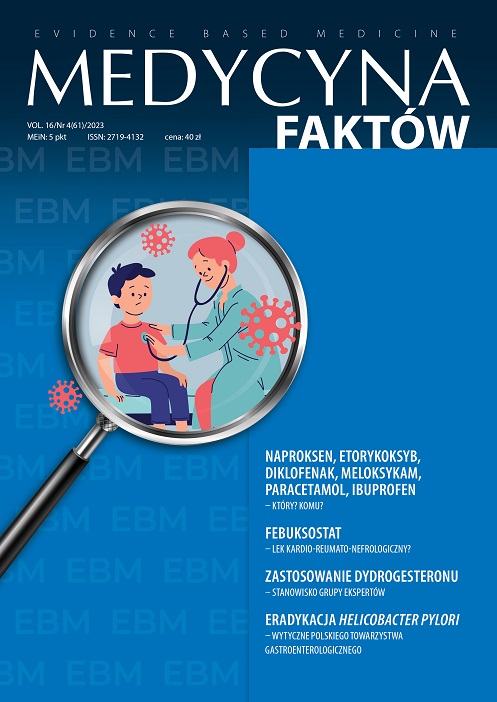Ipratropium bromide in the treatment of cough – new perspective Review article
Main Article Content
Abstract
Acute cough is a very common symptom, most often caused by upper respiratory tract infections. In most cases, it is self-limiting, but sometimes it requires the use of medications. Whereas, chronic cough may be a symptom of many different diseases, requires causal treatment. Frequently used antitussives and mucoactive drugs medications include ipratropium bromide. It is recommended in inhaled form in acute cough associated with acute infections of the upper and lower respiratory tract, in post-infectious cough and in chronic cough associated with chronic bronchitis or chronic obstructive pulmonary disease. Additionally, intranasal ipratropium bromide may be helpful in the treatment of chronic cough associated with chronic non-allergic rhinitis, especially vasomotor rhinitis.
Article Details
Copyright © by Medical Education. All rights reserved.
References
2. Irwin RS, Chang AB, Altman KW. On behalf of the CHEST Expert Cough Panel. Classification of cough as a symptom in adults and management algorithms: CHEST Guideline and Expert Panel Report. Chest. 2018; 153(1): 196-209.
3. Irwin RS, Baumann MH, Bolser DC et al. Diagnosis and management of cough. ACCP evidenced-based clinical practice guidelines. Chest. 2006; 129(1 suppl): 1S-23S.
4. Witek TJ, Ramsey DL, Carr AN et al. The natural history of community-acquired common colds symptoms assessed over 4-years. Rhinology. 2015; 53(1): 81-8.
5. Hryniewicz W, Albrecht P, Radzikowski A. Rekomendacje postępowania w pozaszpitalnych zakażeniach układu oddechowego. Narodowy Program Ochrony Antybiotyków. Narodowy Instytut Leków, Warszawa 2016.
6. Krenke R, Chorostowska-Wynimko J, Dąbrowska M et al. Postępowanie w kaszlu u osób dorosłych – rekomendacje dla lekarzy rodzinnych. Lekarz POZ. 2018; 6(4): 425-52.
7. Kardos P, Dinh QT, Fuchs KH et al. German Respiratory Society guidelines for diagnosis and treatment of adults suffering from acute, subacute and chronic cough. Respiratory Medicine. 2020; 170: 105939.
8. Morice AH, Millqvist E, Bieksiene K et al. ERS guidelines on the diagnosis and treatment of chronic cough in adults and children. Eur Respir J. 2020; 55(1): 1901136.
9. Canning BJ, Chang AB, Bolser DC et al. Anatomy and neurophysiology of cough: CHEST Guideline and Expert Panel report. Chest. 2014; 146(6): 1633-48.
10. Mazzone SB, Farrell MJ. Heterogeneity of cough neurobiology: Clinical implications. Pulm Pharmacol Ther. 2019; 55: 62-6.
11. NICE guideline [NG120]. Cough (acute): antimicrobial prescribing. 2019.
12. Smith SM, Schroeder K, Fahey T. Over-the-counter (OTC) medications for acute cough in children and adults in community settings. Cochrane Database Syst Rev. 2014; 11: CD001831. http://doi.org/10.1002/14651858. CD001831.pub5.
13. Malesker MA, Callahan-Lyon P, Ireland B et al. CHEST Expert Cough Panel. Pharmacologic and Nonpharmacologic Treatment for Acute Cough Associated With the Common Cold: CHEST Expert Panel Report. Chest. 2017; 152(5): 1021-37.
14. Lee AM, Jacoby DB, Fryer AD. Selective muscarinic receptor antagonists for airway diseases. Curr Opin Pharmacol. 2001; 1(3): 223-9.
15. Charakterysyka Produktu Leczniczego.
16. Zanasi A, Lecchi M, Del Forno M et al. A randomized, placebo-controlled, double-blind trial on the management of post-infective cough by inhaled ipratropium and salbutamol administered in combination. Pulm Pharmacom Ther. 2014: 29(2): 224-32.
17. Bateman ED, Rennard S, Barnes PJ et al. Alternative mechanisms for tiotropium. Pulmon. Pharmacol. Ther. 2009; 22(6): 533-42.
18. Korpas J, Widdicombe JG. Aspects of the cough reflex. Respir Med. 1991; 85 Suppl A: 3-5.
19. Dicpinigaitis PV, Spinner LM, Santhyadka GS et al. Effect of tiotropium on cough reflex sensitivity in acute viral cough. Lung. 2008; 186(6): 369-74.
20. Holmes PW, Barter CE, Pierce RJ. Chronic persistent cough: use of ipratropium bromide in undiagnosed cases following upper respiratory tract infection. Respir Med. 1992; 86(5): 425-9.
21. Lowry R, Wood A, Higenbottam T. The effect of anticholinergic bronchodilator therapy on cough during during upper respiratory tract infections. Br J Clin Pharmacol. 1994; 37(2): 187-91.
22. Global Initiative for Chronic Obstructive Lung Disease. Global Strategy for the Diagnosis, Management, and Prevention of Chronic Obstructive Pulmonary Disease: 2023 Report.
23. Appleton S, Jones T, Poole P et al. Ipratropium bromide versus long-acting beta-2 agonists for stable chronic obstructive pulmonary disease. Cochrane Database Syst Rev. 2006; 2006(3): CD006101.
24. Calzetta L, Ritondo BL, Zappa MC et al. The impact of long-acting muscarinic antagonists on mucus hypersecretion and cough in chronic obstructive pulmonary disease: a systematic review. Eur Respir Rev. 2022; 31(164): 210196.
25. Kesten S, Casaburi R, Kukafka D et al. Improvement in self-reported exercise participation with the combination of tiotropium and rehabilitative exercise training in COPD patients. Int J Chron Obstruct Pulmon Dis. 2008; 3(1): 127-36.
26. Vogelmeier C, Hederer B, Glaab T et al. Tiotropium versus salmeterol for the prevention of exacerbations of COPD. N Engl J Med. 2011; 364(12): 1093-103.
27. Decramer ML, Chapman KR, Dahl R et al. Once-daily indacaterol versus tiotropium for patients with severe chronic obstructive pulmonary disease (INVIGORATE): a randomised, blinded, parallel-group study. Lancet Respir Med. 2013; 1(7): 524-33.
28. El Khoury P, Abou Hamad W, Khalaf MG et al. Ipratropium Bromide Nasal Spray in Non-Allergic Rhinitis: A Systematic Review and Meta-Analysis. The Laryngoscope. 2023; 133(12): 3247-55.
29. Dąbrowska M, Arcimowicz M, Grabczak EM. Chronic cough related to the upper airway cough syndrome: one entity but not always the same. Eur Arch Otorhinolaryngol. 2020; 277(10): 2753-59.
30. Hellings PW, Klimek L, Cingi C et al. Non-allergic rhinitis: Position paper of the European Academy of Allergy and Clinical Immunology. Allergy. 2017; 72(11): 1657-65.

